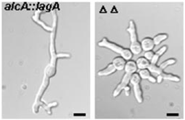Chemistry, Department of: Faculty Series

Liangcheng Du Publications
Document Type
Article
Date of this Version
5-4-2006
Abstract
The genetic manipulation of the biosynthesis of fungal reduced polyketides has been challenging due to the lack of knowledge on the biosynthetic mechanism, the difficulties in the detection of the acyclic, non-aromatic metabolites, and the complexity in genetically manipulating filamentous fungi. Fumonisins are a group of economically important mycotoxins that contaminate maize-based food and feed products worldwide. Fumonisins contain a linear dimethylated C18 chain that is synthesized by Fum1p, which is a single module polyketide synthase (PKS). Using a genetic system that allows the specific manipulation of PKS domains in filamentous fungus Fusarium verticillioides, we replaced the KS domain of fumonisin FUM1 with the KS domain of T-toxin PKS1 from Cochliobolus heterostrophus. Although PKS1 synthesizes different polyketides, the F. verticillioides strain carrying the chimeric PKS produced fumonisins. This represents the first successful domain swapping in PKSs for fungal reduced polyketides and suggests that KS domain alone may not be sufficient to control the product’s structure. To further test if the whole fumonisin PKS could be functionally replaced by a PKS that has a similar domain architecture, we replaced entire FUM1 with PKS1. This strain did not produce any fumonisin or new metabolites, suggesting that the intrinsic interactions between the intact PKS and downstream enzymes in the biosynthetic pathway may play a role in the control of fungal reduced polyketides.


Comments
Published in Journal of Industrial Microbiology & Biotechnology 33 (2006), pp. 859–868. doi 10.1007/s10295-006-0137-9 Journal of Industrial Microbiology & Biotechnology is the official journal published by Springer Verlag for the Society for Industrial Microbiology. Copyright © 2006 Society for Industrial Microbiology. Used by permission. http://www.springerlink.com/content/100967/